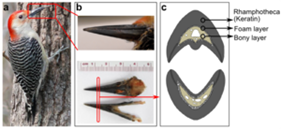Integrated Computational Materials Engineering (ICME)
Woodpecker's Beak
Table 1: Summary of the micro/nano hardness of beaks of three different birds for comparison: woodpecker, toucan, and hornbill [1].
| Microhardness (GPa) | Nanohardness (GPa) | |||
| Rhamphotheca | Bony layer | Rhamphotheca | Bony layer | |
| Woodpecker | 0.32±0.01 | 0.64±0.07 | 0.40±0.08 | 1.16±0.19 |
| Toucan | 0.22±0.012 | 0.27±0.03 | 0.5±0.06 | 0.55±0.12 |
| Hornbill | 0.21±0.015 | 0.39±0.014 | 0.85±0.27 | 0.94±0.21 |
Avian beaks are structural biocomposite materials. Generally, structural biological materials comprise a brittle mineral and ductile protein interacting in a complex structure that is organized in a hierarchical manner [2][3][4]. The macrostructure of bird’s beak is mainly composed of bone and a Β-keratin sheath covering the bone, which is called the rhamphotheca [5][6]. A rhamphotheca grows continuously like fingernails and has a multifunctional role including protecting the beak from ambient moisture and carrying a mechanical load with its viscoelasticity during pecking [7][8]. At the microscale, the rhamphotheca comprises keratin scales with a diameter of approximately 50 μm with the core part of the beak being a closed-cell trabecular-like bone [9][10][11][12]. At the nanoscale level, keratin scales comprise Β-keratin filaments and have a small gap between them. For the multiscale mechanical properties, the Young’s modulus of the rhamphotheca was reported as ~1 GPa for toucans and hornbills with its anisotropy depending on the geometry of the keratin scales. Under compression, the stress plateau occurs at 0.3 MPa for the toucan beak and at 2 MPa for the hornbill beak. At the microscale, the reported value of microhardness for the rhamphotheca was ~200 MPa for the toucan, hornbill, and European starling [13]. Contrary to the rhamphotheca layer, the core part of the beak (considered to be bone) had a wide range of microhardness values with respect to the species; 0.27 GPa for toucan beak and 0.39 GPa for hornbill beaks. Seki et al. also reported the nanohardness of the toucan beaks were 0.5 GPa and 0.55 GPa for the rhamphotheca and the foam trabeculae, respectively. The nanohardness of the hornbill beaks were 0.85 GPa and 0.94 GPa for the rhamphotheca and the trabeculae, respectively (Table 1).
- Structural scale of the beak
- Woodpecker Head Simulation

(a) A male Red-Bellied Woodpecker, (b) upper and lower beaks of the woodpecker, and (c) a schematic of the cross-sectional view of the woodpecker beak comprising three layers; outer rhamphotheca, middle foam, and inner bony layers.
The beaks of an adult Red-Bellied Woodpecker (Melanerpes carolinus), which
is a medium sized bird living in the southern United States, were studied for
structure-property relationships. The woodpeckers obtained had body lengths of
24~25 cm. The upper and lower beaks were separated from the body as shown in
Fig. 1(b), and all tests were carried out at ambient conditions.
The full length of the beak is about 4 cm, and the cross-section of the
woodpecker beak is composed of the outer rhamphotheca layer, the middle foam
layer, and the inner bony layer as the schematic of Fig. 1c illustrates. The
upper beak has a cavity in the center of the beak, which decreases the weight
while still keeping the bending resistance fairly high. The curvature of the
tip of the upper beak was measured at 19.07 mm-1, and that of the
lower beak was approximately 12.01 mm-1. The density of the upper
beak was 1.1 g/cm3, and that of the lower beak was 1.348
g/cm3 measured using the Archimedes method
[1]. The lower density of the upper
beak is due to the cavity and more porous area at the root part of the upper
beak [2].
Reference
1. P. Roman and J. M. Gutierrez-Zorrilla, "A quick method for determining
the density of single crystals," Journal of Chemical Education, vol. 62, p.
167, 1985.
2. F. Backhouse, Woodpeckers of North America, 2005.
